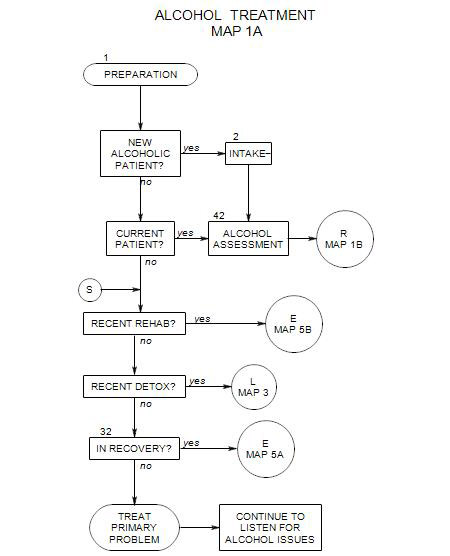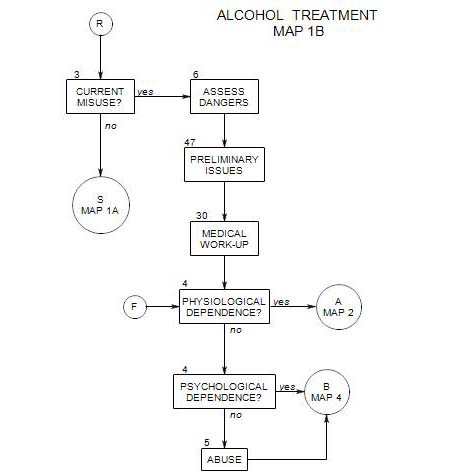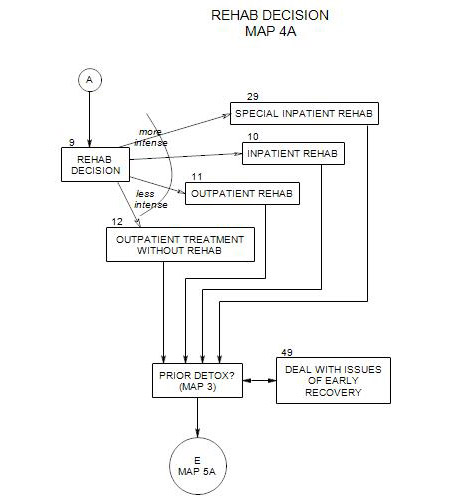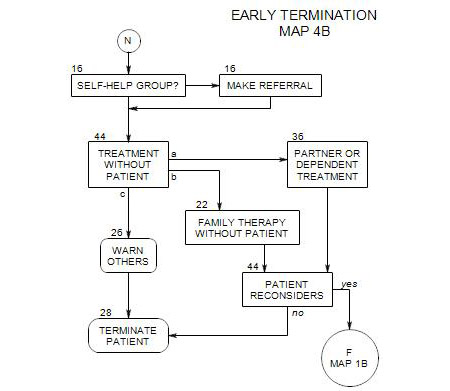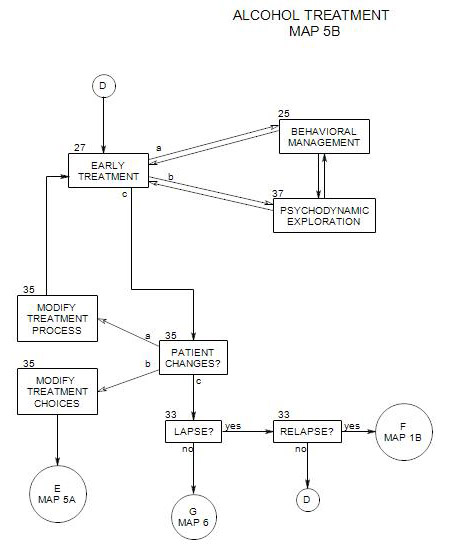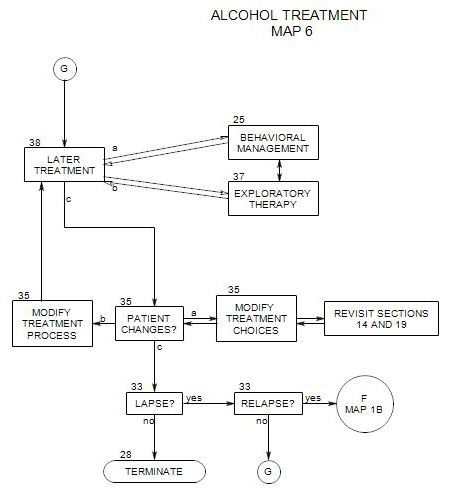9. REHABILITATION DECISION
- This section applies to any alcoholic patient for whom treatment other than detox is planned. As indicated above, you may also have to make this decision for some patients following detoxification.
Rehabilitation refers to a formal program for patients who have just gotten sober, to help them remain sober. In this it is distinct from detox, which is the process of ending physiological dependency on alcohol. The goal is to change people’s attitudes toward drinking, and return them to normal life as more effective people, without the need for alcohol.
The aim of the rehabilitation process is to provide the patient with temporary, external help in
- gaining alcohol and drug information;
- preventing continued use, and
- returning to normal functioning.
If the patient has input detoxification [ Section 7 ], further treatment will be recommended by the hospital, almost certainly a form of rehabilitation. In that case, the responsibility for choosing the level of intensity of the next stage of treatment rests with the hospital transition and placement staff, although they may be in touch with you if they know that you are actively involved with the patient. If the patient has outpatient detoxification, the treatment staff is likely to recommend a less intense form of rehabilitation.
The clinician’s job at this point is to make an assessment of the patient’s need for treatment and choose a level of care that will [1] support the recovery process, [2] not overly strain personal resources, and [3] disrupt the patient’s life as little as possible. It may also be necessary to convince the patient of the need for treatment; and when rehabilitation is the placement of choice, negotiate with a treatment facility and arrange to get the patient there.
For many patients, this is a difficult decision to make, because there are a number of different considerations that affect your choice. In the following parts of this section we consider
a. the major levels of treatment available
b. some specific issues affecting the choice of treatment level
c. making the decision
d. getting a patient to a rehabilitation facility
This decision point is organized around the choice of form of rehabilitation, or “Rehab”. Rehab may be offered in varying levels of intensity. Commonly, the initial recommendation is for a relatively intense experience, with reducing intensity as the patient’s recovery progresses.
9a. Levels of Care
There are several possibilities here:
INPATIENT REHABILITATION
In inpatient rehabilitation, the patient is maintained in a residential or hospital-like setting, for a variable period of time, depending on the nature of the facility and the patient’s need and ability to pay. A stay of 28 days is common and usually considered effective. Many consider a stay of 90 days to be substantially more effective in preparing a patient for long-term recovery. A patient’s actual length of stay may be determined by the patient’s outside responsibilities, insurance coverage, or ability to pay. The treatment plan can also be affected by a patient’s need for initial detoxification [ Section 7 ].
This is the treatment of choice for the patient who needs one or more of the following in order to stay sober: (1) continuous monitoring; (2) separation from his/her normal environment and its pressures, and/or (3) initial guidance and support from professionals and peers. It is also the treatment of choice for a person who is impulsive, or resistant to treatment, or who has history of relapse or a lack of social and emotional support in his/her home environment.
The treatment routine is very structured, and commonly includes most of the following:
- daily group therapy, with experience in finding support from others
- daily AA meetings, either at the facility or nearby
- an alcohol education series, with information on the nature of addiction, the effects of alcohol on a person’s body and thinking, and the short- and long-term consequences of drinking
- nutritional counseling
- a medical work-up
- recreation
- counseling about triggers, relapse avoidance, and ways to move on without drinking
- anger management in some cases
- and possibly individual psychotherapy.
Patients are often asked to keep a diary or journal, as an aid to treatment.
Inpatient programs are designed to deal with patients who require a stable environment for rehabilitation or who need full time management because of a psychological disorder. They are also valuable for people who need to get away from their normal environments for a period of time in order to stop drinking.
If you have information about your patient’s background or treatment needs that you think can be helpful, you should contact the intake staff as soon as possible. Once your patient has signed a release, you can pass your information on to them.
Family contact is attempted immediately. However, family/marital treatment usually occurs later in the treatment (the third week, in a 28-day stay), when the patient is more stabilized. This is a prelude to discharge planning.
If possible, get a release from your patient before he/she leaves for the treatment facility, then contact the intake staff as soon as possible after he/she arrives. If not, the staff may arrange to obtain a release to talk with you. Then you can let them know that the patient was seeing you for outpatient treatment prior to intake, that you are prepared to keep in contact with him/her by telephone, and that you are available to see him/her again upon discharge. When staff are not available for individual treatment, it may be possible for you to have regular telephone sessions while he/she is there.
Upon discharge, a variety of arrangements may be made, depending on the judgment of the hospital staff regarding need, finances, etc., and the patient’s preferences. These could include
- outpatient rehab
- ongoing psychotherapy with the patient’s prior therapist or another
- residence in a halfway house or sober house
- support group contacts
- ongoing alcohol counseling or other adjunctive care [See Section 19]
DUAL DIAGNOSIS TREATMENT
If a patient has a serious medical condition or mental illness in addition to alcohol misuse, a specialized treatment facility may be necessary. Ideally, the total milieu is supportive of patients with multiple issues, and staff are trained to recognize and manage patients with a wide range of diagnoses in addition to alcohol misuse.
People with severe mental illnesses typically need long term assistance with issues of living: housing, jobs, dealing with various public agencies, and so on, in addition to work on intrapsychic and interpersonal issues. A dual diagnosis agency or hospital may offer special programs and recommend an inpatient stay of 90 days or more. Upon discharge from inpatient treatment, some services may continue to be available on an outpatient basis for an extended period of time.
There may be a greater emphasis, compared to other settings, on
- counseling on coping strategies
- social support
- family involvement
- ongoing medical care
- coordination of services
A patient with a serious medical disorder in addition to an alcohol addiction may best be served by a hospital with a specialty in addictions. Here a major issue would be coordinating the various medications and other treatments the patient needs.
Follow-up:
The type of follow-up needed by a person with both alcohol and medical or psychological issues needs depends both on the risk of relapse and the severity of the person’s other issues
A patient with a severe mental illness is typically not a good candidate for private practice treatment because of his/her difficulties in coping with everyday life. Such a person would be better referred to a specialized outpatient treatment facility, where additional services are immediately available. If you do take on such a person, you may need to find additional resources somewhere outside your practice.
A patient with a milder disorder or one that can be managed with medication and can cope effectively with daily life in the outside world may do well in a private practice psychotherapy setting. Even so, careful attention to adjunctive treatments [Section 19] is often an essential part of the work. An outpatient psychotherapist may become part of a team for these purposes, with overall care coordinated by an agency.
OUTPATIENT REHABILITATION
Outpatient rehabilitation exists on a continuum with respect to the level of intensity of services offered. Commonly it includes many of the same components as inpatient rehabilitation: medical work-up, nutritional counseling, AA meetings, group therapy, an alcohol education series, individual psychotherapy, and family involvement.
More intensive outpatient rehabilitation usually involves 3-4 patient hours per day, 4 or more days per week, for a year to 18 months. This modality is commonly also known as alcoholism day treatment.
It may be the treatment of choice for a patient who needs a lot of support, information, help with management, etc, but who can maintain abstinence while unsupervised for part of each day, and either (a) can’t afford inpatient treatment or (b) can make time in each day for treatment but can’t afford to be away from his/her regular (family or job) responsibilities for an extended period of time. It also assumed that the patient can make use of other personal and community resources as needed, to remain sober.
Often rehabilitation is offered in modules of varying lengths of time, depending on the goals of the modules.
Less intensive outpatient rehabilitation involves either fewer services or less frequent therapy contacts. In this case, increased family involvement may provided some of the needed services.
PSYCHOTHERAPY WITHOUT REHABILITATION
Some form of formal rehabilitation should be offered to every person who has been misusing alcohol. However, some people will refuse it, for a variety of reasons. These could include –
- hardship re taking the time or leaving responsibilities.
- financial issues, either in taking time from work or in paying for the rehab.
- a history of prior rehabilitations and the expectation of diminished returns from another one.
- lack of availability of adequate rehabilitation programs.
Treatment involves a less intense focus on either drinking or life skills than rehabilitation. Typically a patient is seen on a regular basis, with the primary form of treatment either individual or group psychotherapy, and adjunctive treatment and services as needed. In many ways it is similar to regular outpatient psychotherapy.
It is a risky choice, when a patient has recently been unable to manage drinking on his/her own and now is attempting to return to his/her former life without the break and additional resources of rehabilitation. That risk should be clear to the patient as part of the process of deciding not to participate in a program.
There are positive and negative sides to treatment under these circumstances:
On the positive side, by keeping the patient in treatment, movement toward identification and control of the drinking problem is still an option, even when the focus is on other issues.
On the negative side, the possibility exists of unintentionally colluding with the patient to avoid the alcohol problem by focusing elsewhere; and that single issue can mask and exacerbate all of the patient’s other issues. There also may be a problem of insurance coverage for individual psychotherapy when alcohol misuse is listed as the primary diagnosis.
This may be a reasonable choice for some patients, especially if the following conditions are met:
- a history of prior long periods of recovery, indicating a potential for staying sober.
- the patient is resistant to rehabilitation.
- the patient offers no apparent danger to others, even if he/she lapses [e.g.: he/she is unlikely to be violent or drive drunk].
- availability of support for sobriety in the patient’s daily life, making rehab less important.
- a sense that a formal rehab program would be a hardship
AND
- your judgment that meetings and psychotherapy will be enough to help the person stay in recovery, based on his/her level of internal structuralization, relatively weak and infrequent urges to drink and habits of drinking.
- patient’ is in the action stage of change [Section 47] relative to drinking and committed to psychotherapyfor both drinking and other issues.
- patient’s commitment to recovery (e.g.: willingness to do a “90 in 90”: a meeting each day for 3 months) and availability of ways for coping with cravings.
Even with all these conditions, you may be reluctant to take the person into psychotherapy without rehab. In this case, you can offer a trial of outpatient therapy, with a clear agreement that the patient will go for more intensive treatment if this is unsuccessful. Such a trial should probably include additional services and the involvement of others as well.
If the patient fails to meet the above conditions for psychotherapy but still refuses rehab entirely, the question still is whether to see the patient for further treatment. If the patient is in no immediate danger and offers no clear danger to others, psychotherapy is still a possibility – and could be successful. Individual psychotherapy, in the context of a formal rehab or not, offers the possibility of examining the behavioral, emotional and cognitive antecedents of drinking. This in turn permits development of a treatment plan that optimally suits the patient and has the greatest chance of helping him/her stay sober and improve his/her life. It is also possible, based on individual considerations, to refuse to see the patient and refer him/her elsewhere or suggest that’s/he come back when ready.
9b. Patient Issues Affecting the Choice of Rehab
Several variables should be considered in choosing an appropriate level of care for a patient. Some major concerns follow:
AVAILABLE SUPPORT
- the amount of social and emotional support available to the patient in his/her everyday life, through social and family relationships, and his/her ability to make use of it. When there is greater support, less intensive care may be indicated.
- the amount of additional physical and emotional support the person needs. The greater the need, the more intensive care that may be required.
- the possible impact, positively and negatively, of level of care on the patient’s relationships with significant others. It may be either helpful or hurtful for a person to be away from family and friends for a while.
FINANCIAL CONSIDERATIONS
- Inpatient treatment is commonly more expensive that outpatient treatment; private treatment costs more than publicly funded treatment.
- the patient’s ability to pay for treatment, and the availability of insurance coverage for the various treatments you are considering. Insurance plans may pay for some treatments and not others, for treatment at some facilities and not others
- A patient may lose income, if outpatient rehabilitation conflicts with working hours. (Work is not possible when inpatient rehabilitation is used.)
HISTORY
- previous treatment and relapse history can give an indication of the intensity of external structure the person needs, as well as the length of time for which support should be offered.
- legal history: a history of legal entanglements connected with alcohol abuse suggests a need for greater structure.
ATTITUDE
- the patient’s stage of change [ Section 47 ]. A patient in the contemplation or preparation stage may benefit from the group work and education provided. A person in the action stage could do well in inpatient rehab and possibly as well or better in outpatient treatment.
PATIENT SYMPTOMS
- the possible need for inpatient medical treatment of physical health issues: e.g.: malnutrition, loss of consciousness, peripheral neuropathy, etc., might lead you to select a more intensive level of care.
- the presence of another psychological disorder could affect both the level of intensity needed and the type of treatment that will be effective, most likely suggesting a need for more intensive or specialized care.
PERSONAL RESPONSIBILITIES
- The time requirements of rehab can interfere with the patient’s ability to meet other responsibilities, such as having a job or caring for other family members (such as young children or incapacitated adults). The more intense and longer the treatment, the more likely it is to interfere.
- On the other hand, an alcoholic patient may fail to perform responsibilities adequately or safely when present
- The long-term risks of inadequate alcohol treatment may be considerable. It may pay to pressure the patient toward more intense rehabilitation despite the short-term costs.
TIME MANAGEMENT
- The consistency of the patient’s vocational functioning for the past five years. A person who has functioned in a reliable and consistent way may need less additional structure from a treatment program.
- Whether the person currently has a job, and if so, how demanding it is. A person who is not working and has a lot of time on his/her hands may find it more difficult to remain abstinent and have greater need for a structured [probably inpatient] program.
- The patient’s availability of, and use of leisure time. A person without hobbies or other leisure pursuits will be at greater risk for relapse. A patient who is ready for substantial self-help group involvement may use that involvement to replace time that was previously spent drinking. If he/she has a lot of free time that is unaccounted-for, a more intensive rehab experience may be indicated.
- The patient’s involvement with family in positive ways that fill time. People who have more support from family and friends at home are less at risk for relapse.
RELAPSE RISK
In a sense, all of these issues have to do with relapse. Still there may be a feeling the therapist gets about a particular patient, relative to his/her likelihood of benefitting from a particular program or likelihood of relapse, that can’t be expressed as a general rule or consideration.
OTHERS
- types of programs available and the patient’s ability to make use of what is offered. Ideally, the patient will see him/herself as belonging with the selected treatment. The patient’s participation in selecting a treatment plan may increase the likelihood that he/she will follow the plan.
- whether the patient has recently been through detoxification. If so, the structure of a formal rehabilitation program may be a necessary support in the transition back to normal living.
- the amount of risk that the patient causes, for self and others. A person who is endangering his/her own health or the safety of self and others (e.g., through fighting, spouse abuse or drunk driving) may need a more restrictive level of care until the risk abates.
9c. Issues Affecting Choice of a Particular Facility
Having chosen a kind of treatment facility for a patient, the next step is to find the options available for treatment. Probably the best resources are other local professionals who are familiar with nearby treatment facilities. If that approach doesn’t work, a comprehensive national listing of alcohol and mental health treatment facilities by location can be found at the U.S. Substance Abuse and Mental Health Services Administration web site, findtreatment.samhsa.gov.
Within each category, treatment facilities differ in many ways that affect the treatment process, patient response, and the overall outcome of treatment. These include
- Location. [1] Generally, the closer a facility is to the patient’s home the better, for ease of access to patient and family. [2] Ease of access is also important in case the patient relapses and wants to return to the same place. [3] It is also possible that personal contacts made during rehabilitation will continue after treatment, if people’s homes are near to each other. These contacts can provide continuing support after the person leaves rehab.
- Cost. Facilities vary widely in the amount they charge, depending on many factors, including the services they offer and the quality and luxury of the living spaces.
- Comprehensiveness of program offered
- Responsiveness and effectiveness of professional and nonprofessional staff
- Comfort of the living and treatment spaces, for inpatient treatment centers
- Reputation. This is difficult to determine, except through reports from other professionals and previous patients.
- Whether the facility is publicly supported or private. Private facilities can be very expensive, depending on the quality of the setting and the cost of services provided.
9d. Getting the Patient to a Treatment Facility
When sending a patient for intensive care, you should be familiar with the facility, the personnel, and the procedures for admission. This will make it easier for you to convince the patient to go, and ease the transition. It also might give your referral some priority status with the facility.
Also, if this is a first attempt at outpatient work with a patient and the patient is very resistant to rehabilitation, you might initiate a trial of outpatient services, eg: AA plus psychotherapy, with an agreement that the patient will go for rehabilitation if the trial is ineffective.
You may have to convince the patient to go. Discuss the reasons for recommending a treatment at a particular level of intensity, and the dangers of refusal. The approach you use will be affected by many things, including the patient’s stage of change [ Section 47 ].
The patient should be made aware that the level of treatment you have chosen is only tentative and subject to re-evaluation and change by the staff of the treatment facility or clearing house.
9e. Continuation of Care
Once the patient is under the care of the treatment facility, it becomes the responsibility of that program to re-assess the level of treatment. As the patient progresses, the treatment will be modified further. Eventually, the patient will be referred back to the original therapist and/or to alcoholism outpatient treatment. If you have maintained regular contact with you patient and the staff at the facility, it is very likely that the staff will consult you about this choice.
